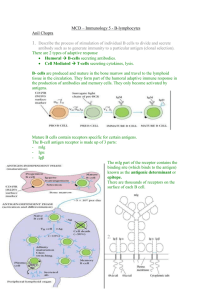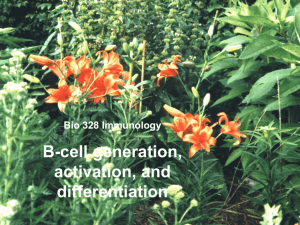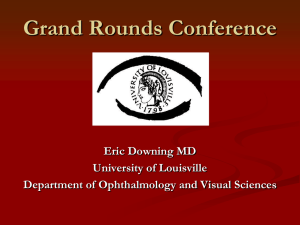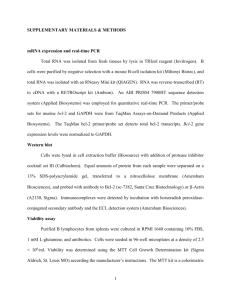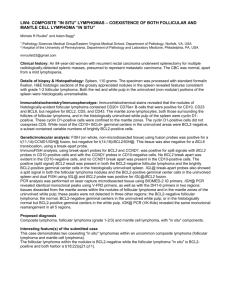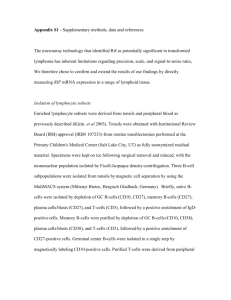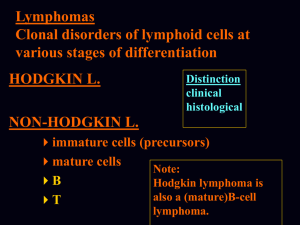Prominent Clonal B-Cell Populations Identified Proliferations
advertisement
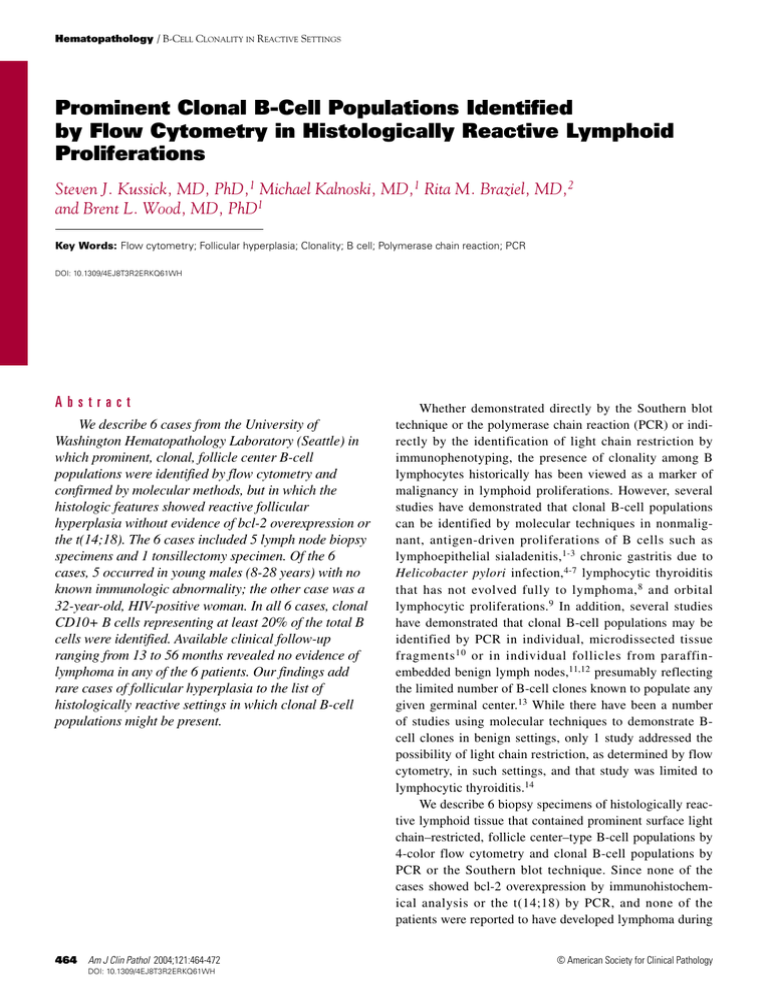
Hematopathology / B-CELL CLONALITY IN REACTIVE SETTINGS Prominent Clonal B-Cell Populations Identified by Flow Cytometry in Histologically Reactive Lymphoid Proliferations Steven J. Kussick, MD, PhD,1 Michael Kalnoski, MD,1 Rita M. Braziel, MD,2 and Brent L. Wood, MD, PhD1 Key Words: Flow cytometry; Follicular hyperplasia; Clonality; B cell; Polymerase chain reaction; PCR DOI: 10.1309/4EJ8T3R2ERKQ61WH Abstract We describe 6 cases from the University of Washington Hematopathology Laboratory (Seattle) in which prominent, clonal, follicle center B-cell populations were identified by flow cytometry and confirmed by molecular methods, but in which the histologic features showed reactive follicular hyperplasia without evidence of bcl-2 overexpression or the t(14;18). The 6 cases included 5 lymph node biopsy specimens and 1 tonsillectomy specimen. Of the 6 cases, 5 occurred in young males (8-28 years) with no known immunologic abnormality; the other case was a 32-year-old, HIV-positive woman. In all 6 cases, clonal CD10+ B cells representing at least 20% of the total B cells were identified. Available clinical follow-up ranging from 13 to 56 months revealed no evidence of lymphoma in any of the 6 patients. Our findings add rare cases of follicular hyperplasia to the list of histologically reactive settings in which clonal B-cell populations might be present. 464 464 Am J Clin Pathol 2004;121:464-472 DOI: 10.1309/4EJ8T3R2ERKQ61WH Whether demonstrated directly by the Southern blot technique or the polymerase chain reaction (PCR) or indirectly by the identification of light chain restriction by immunophenotyping, the presence of clonality among B lymphocytes historically has been viewed as a marker of malignancy in lymphoid proliferations. However, several studies have demonstrated that clonal B-cell populations can be identified by molecular techniques in nonmalignant, antigen-driven proliferations of B cells such as lymphoepithelial sialadenitis,1-3 chronic gastritis due to Helicobacter pylori infection,4-7 lymphocytic thyroiditis that has not evolved fully to lymphoma, 8 and orbital lymphocytic proliferations.9 In addition, several studies have demonstrated that clonal B-cell populations may be identified by PCR in individual, microdissected tissue fragments 10 or in individual follicles from paraffinembedded benign lymph nodes,11,12 presumably reflecting the limited number of B-cell clones known to populate any given germinal center.13 While there have been a number of studies using molecular techniques to demonstrate Bcell clones in benign settings, only 1 study addressed the possibility of light chain restriction, as determined by flow cytometry, in such settings, and that study was limited to lymphocytic thyroiditis.14 We describe 6 biopsy specimens of histologically reactive lymphoid tissue that contained prominent surface light chain–restricted, follicle center–type B-cell populations by 4-color flow cytometry and clonal B-cell populations by PCR or the Southern blot technique. Since none of the cases showed bcl-2 overexpression by immunohistochemical analysis or the t(14;18) by PCR, and none of the patients were reported to have developed lymphoma during © American Society for Clinical Pathology Hematopathology / ORIGINAL ARTICLE follow-up periods ranging from 13 to 56 months, these cases seem to represent benign clonal proliferations of follicle center B cells. Materials and Methods The 6 cases in this series were selected to have both flow cytometric and molecular evidence of clonality in the setting of reactive-appearing morphologic features. All cases were identified in the University of Washington Hematopathology Laboratory from January 1998 through December 2002. Two additional cases showing light chain–restricted B-cell populations by flow cytometry but in which clonal B-cell populations could not be identified by PCR or the Southern blot technique were not included in the series. The procedures used in the study were approved by the University of Washington Human Subject Review Committee (No. 02-3505-E 01) and were in accord with the ethical standards established by the Helsinki Declaration of 1975.15 Flow Cytometric Analysis In all cases, the fresh tissue was collected in RPMI supplemented with 10% fetal calf serum. To increase the number of cells for analysis, these specimens were finely minced and strained through 40-µm cell strainers (Becton Dickinson [BD], San Jose, CA) during processing. The cells were washed once in a solution of phosphate-buffered saline/0.3% bovine serum albumin/0.1% sodium azide, resuspended in 100 µL of RPMI/10% fetal calf serum, incubated with the relevant antibodies for 15 minutes at room temperature in the dark, washed again in phosphate-buffered saline/bovine serum albumin/azide, and fixed in 1% paraformaldehyde before flow cytometric analysis. All antibodies used in the flow cytometric analysis were conjugated to fluorescein isothiocyanate (FITC), phycoerythrin (PE), PE-Texas Red (ECD), or PE-Cy5. The specific fluorochromes and clones used in the flow cytometric analysis of the B cells were as follows: CD10-FITC (clone D12, BD) or CD10-PE (clone HI10a, BD), CD19-ECD (clone HD237, Beckman Coulter [BC], Hialeah, FL), CD20-FITC (clone H299, BC) or CD20-PE (clone L27, BD), CD45-ECD (clone J.33, BC), CD5-PE-Cy5 (clone BL1a, BC), κ-FITC (clone TB 28-2, BD), and λ-PE (clone 1-155-2, BD). In each case, the amount of antibody used was based on the manufacturer’s suggestion or titration experiments to optimize the signal/noise ratio. In all cases, the B cells were evaluated using the following 4-color combinations: κ-FITC, λ-PE, CD19-ECD, CD5-PE-Cy5 and CD20-FITC, CD10-PE, CD19-ECD, CD45-PE-Cy5 or CD10-FITC, CD20-PE, CD19-ECD, CD45-PE-Cy5. To facilitate the demonstration of light chain restriction in 3 of the 6 cases, additional 4-color antibody combinations were used to separate the follicle center population from the non–follicle center B cells based on the increased CD10 or CD20 expression of the former: κ-FITC, λ-PE, CD19-ECD, CD10-PE-Cy5 (1 case) or κ-FITC, λ-PE, CD19-ECD, CD20-PE-Cy5 (2 cases). In all cases, the flow cytometry was performed on Coulter Epics XL instruments (BC). In all cases, more than 10,000 cellular events were analyzed per tube of antibodies, and in several cases, 100,000 cellular events were analyzed per tube. The flow cytometric data were compensated and analyzed on Macintosh G3 or G4 computers (Apple, Cupertino, CA) using Winlist software (Verity House Software, Topsham, ME) or software developed in our laboratory (B.L.W.). In all cases, events with very low forward scatter, which were likely to include degenerated cells, were excluded from the analysis by forward vs side scatter gating. CD19 vs side scatter gating was used to limit the flow cytometric analysis to the B cells. Histologic and Immunohistochemical Analysis All cases were evaluated by using H&E staining, immunohistochemical analysis of bcl-2 expression, and in situ hybridization to detect Epstein-Barr virus (EBV) early RNA 1 (EBER1) messenger RNA. All immunohistochemical and in situ hybridization studies were performed in the University of Washington Immunohistochemistry Laboratory. For the bcl-2 immunohistochemical analysis, a 4-µm-thick section from 1 representative paraffin block of each case was deparaffinized, rehydrated in graded alcohol, blocked with 3% hydrogen peroxide, and subjected to heat-induced epitope retrieval. After cooling, the anti–bcl-2 monoclonal antibody 124 (DakoCytomation, Carpinteria, CA) was applied and incubated for 40 minutes. Immunolocalization was performed via a modified avidin-biotin immunoperoxidase technique with a ferric chloride–enhanced 3,3'-diaminobenzidine chromogen. Finally, sections were counterstained with hematoxylin. Positive and negative control samples were used for each immunohistochemical stain. For the EBV in situ hybridization, a 4-µm-thick section from 1 representative paraffin block of each case was deparaffinized, rehydrated in graded alcohol, and treated with 0.02 mg/mL of Proteinase K followed by 70% and 95% ethanol, before the application of a biotinylated probe to EBER1 messenger RNA (Operon Technologies, Alameda, CA). After a 40-minute incubation, the slide was washed, blocked with 3% hydrogen peroxide, and incubated with a mouse antibiotin antibody. Immunolocalization was performed as described in the preceding paragraph. Am J Clin Pathol 2004;121:464-472 © American Society for Clinical Pathology 465 DOI: 10.1309/4EJ8T3R2ERKQ61WH 465 465 Kussick et al / B-CELL CLONALITY IN REACTIVE SETTINGS Molecular Analysis Fresh or frozen tissue samples were available for analysis in all 6 cases. Genomic DNA was extracted using the Puregene kit (Gentra Systems, Minneapolis, MN) according to the method of the manufacturer, precipitated with 70% ethanol, and resuspended in tris(hydroxymethyl) aminomethane (Tris)–buffered EDTA. For the PCR analysis of immunoglobulin heavy chain (IgH) gene rearrangements, 500 ng of DNA was incubated with 1 U of Taq polymerase (Amplitaq, Applied Biosystems, Foster City, CA) and 200µmol/L concentrations of deoxynucleoside triphosphates, in buffer containing a 12-mmol/L concentration of Tris (pH 8.3), a 1.2-mmol/L concentration of magnesium chloride, a 60-mmol/L concentration of potassium chloride, and 0.6 µg/µL of bovine serum albumin. Consensus primers against complementarity determining region 3 (5'-ACACGGC(C/T0GT(G/A)TATTACTGT-3') and the JH region (5'-ACCTGAGGAGACGGTGACC-3') of the IgH gene were used for the PCR amplifications. For the cases analyzed since the year 2000, the primer sets included a fluorescent (Hex)-labeled primer, permitting the products to be size-fractionated by capillary electrophoresis using an Applied Biosystems ABI 310 Sequence Analyzer with Genescan software. For cases before 2000, unlabeled PCR primers were used, and the products were size-fractionated by using agarose gel electrophoresis with ethidium bromide staining. Negative and positive control samples for clonality were used in all assays. For Southern blot analysis, DNA was digested with HindIII, BamHI, and EcoRI (all from Boehringer Mannheim/Roche, Indianapolis, IN) for 12 to 16 hours (overnight), size-fractionated on 0.7% agarose gels, and transferred to nylon filters (Nytran Supercharge, Schleicher & Schuell, Keene, NH) for 1 hour in a buffer of 5% standard saline citrate. The blots were hybridized for 12 to 16 hours with a phosphorus 32–labeled probe directed against the IgH gene, in a sodium dodecyl sulfate hybridization buffer. Autoradiograms typically were exposed to the blot for 24 and 72 hours. Positive and negative control samples were used in all assays. For the PCR reactions to detect the t(14;18), the unlabeled bcl-2 gene–derived primers MBR1 (5'-CGGGAATTCTTTGACCTTTAGAGAGTTGCTT-3'), MC7 (5'CGGGAATTCTCAGTCTCTGGGGAGGAGTGG-3'), and MC8 (5'-CGGGAATTCGACTCCTTTACGTGCTGGTACC-3') were used in separate PCR reactions with the JH primer 5'-CTCAAGCTTACCTGAGGAGACGGTGACC3'. The products were size-fractionated using agarose gel electrophoresis with ethidium bromide staining. Positive and negative control samples were used in all assays. Results The 6 cases in this series are summarized in ❚Table 1❚. In all cases a prominent, surface light chain–restricted B-cell population representing more than 20% of the total B cells was identified at the first sampling of the lymphoid tissue. In case 5, the initial sampling was a fine-needle aspiration (FNA). Because of the identification of a B-cell clone in the FNA sample, a second excisional biopsy was performed that revealed the same abnormal B-cell population, although in a lower percentage of the total B cells compared with the FNA sample. In the remaining 5 cases, the first sampling of the lymphoid tissue was an excisional biopsy. Five of the 6 cases occurred in males younger than 30 years who had localized enlargement of lymphoid tissue, predominantly in the head and neck region, and no apparent history of immunologic problems. The other biopsy was from a 32-year-old, HIV-positive woman with a peripheral blood CD4+ cell count of 240/µL (240 × 106/L) at the time of the biopsy. ❚Table 1❚ Cases With Light Chain–Restricted CD10+ B Cells and Reactive Histologic Findings Case No./ Sex/Age (y) 1/M/8 2/F/32 3/M/14 4/M/17 5/M/28 6/M/10 Known Immune Disorder Biopsy Site Histologic Findings No HIV No No No No Tonsil Cervical LN Cervical LN Inguinal LN Cervical LN Parotid LN FH FH FH FH FH FH/PTGC Follicle Center λ Ratio B-Cell κ/λ 0.35 4.3 10.2 0.13 9.0 12.5 Estimated Clonal Molecular Follicle Center B Cells* Results† 32 55 21 41 35 and 16§ 27 –/+ +/+ +/ND –/+ –/+ +/ND Duration of Follow-up (mo)‡ 56 53 50 40 39 13 FH, follicular hyperplasia; LN, lymph node; ND, not done; PCR, polymerase chain reaction; PTGC, progressive transformation of germinal centers. * Results are given as percentage of clonal CD10+ B cells among all B cells, based on flow cytometry. Note that all clonal follicle center B-cell populations expressed essentially normal levels of CD19 (intermediate level), CD20 (intermediate to bright), and CD10 (low to intermediate), without CD3 or CD5. Owing to the straightforward follicle center immunophenotype in these cells, we did not examine additional follicle center B cell–associated antigens such as CD23, CD38, or FMC7. † Results are given for PCR/Southern blot analysis. ‡ Negative follow-up is based on lack of a subsequent biopsy of lymphoid tissue at the referring institution (for all but case 2) and lack of evidence of lymphoma in the available clinical history. For case 2, a second lymph node biopsy was performed approximately 1 year after the initial biopsy; a clonal B cell population was not found. § Results are for samples obtained by fine-needle aspiration of the lesion and excisional biopsy, respectively. 466 466 Am J Clin Pathol 2004;121:464-472 DOI: 10.1309/4EJ8T3R2ERKQ61WH © American Society for Clinical Pathology Hematopathology / ORIGINAL ARTICLE In all cases, the light chain–restricted B-cell populations identified by flow cytometry were of follicle center type, showing the characteristic follicle center–associated expression of low- to intermediate-level CD10 and slightly brighter CD20 and CD45 compared with the polyclonal non–follicle center B cells in the specimen ❚Image 1❚ and ❚Image 2❚ (cases 3 and 2, respectively). Based on their forward and side lightscatter characteristics, the light chain–restricted B cells also tended to be larger than the polyclonal B cells in the specimen. Four of the cases were κ light chain–restricted, while the other 2 were λ-restricted. The levels of CD19 in the clonal populations in this series were very similar to those of the polyclonal B cells in the background. In addition, the levels of expression of CD10, CD20, and CD45 were similar to those typically seen by using flow cytometry in benign, polyclonal follicle center populations. In case 6, cytoplasmic Lymphocytes FS B cells CD19 ECD Follicle center B cells λ PE CD10 PE CD45 PC5 SS LOG Viable cells bcl-2 protein expression was assessed by flow cytometry, and there was no evidence of overexpression of bcl-2 in the follicle center B cells (data not shown). Molecular analysis of the IgH gene confirmed clonal Bcell populations in all 6 cases. PCR analysis identified clonal B cell populations in a variable background of polyclonal B cells in 3 of the 6 cases ❚Image 3❚ and ❚Image 4❚. In case 2, Southern blot analysis confirmed the presence of a clonal Bcell population (Image 4), whereas in cases 3 (Image 3) and 6, the PCR positivity was confirmed by repeated PCR assays. In the 3 PCR-negative cases, Southern blot analysis demonstrated novel, rearranged bands that were not present in the germline control (placental DNA), indicating the presence of a clonal B-cell population (data not shown). ❚Image 5❚ and ❚Image 6❚ summarize the histologic and immunohistochemical findings in cases 3 and 2, respectively. κ FITC CD20 FITC ❚Image 1❚ (Case 3) Florid follicular hyperplasia in a cervical lymph node. Four-color flow cytometric evaluation demonstrates a clonal follicle center B-cell population (blue) showing normal expression of CD45 and CD19 (second dot-plot from left), low-level CD10, and increased CD20, compared with the non–follicle center B cells (second dot-plot from right), and κ light chain restriction (rightmost dot-plot). ECD, PE-Texas Red; FITC, fluorescein isothiocyanate; FS, forward light scatter; PC5, PE-Cy5; PE, phycoerythrin; SS, side light scatter. Lymphocytes FS B cells CD19 ECD B cells λ PE CD10 PE CD45 PC5 SS LOG Viable cells κ FITC CD20 FITC ❚Image 2❚ (Case 2) Florid follicular hyperplasia in a cervical lymph node. Four-color flow cytometric evaluation demonstrates a clonal follicle center B-cell population (blue) showing normal expression of CD45 and CD19 (second dot-plot from left), lowintermediate CD10, and increased CD20, compared with the non–follicle center B cells (second dot-plot from right), and κ light chain restriction (rightmost dot-plot). ECD, PE-Texas Red; FITC, fluorescein isothiocyanate; FS, forward light scatter; PC5, PECy5; PE, phycoerythrin; SS, side light scatter. Am J Clin Pathol 2004;121:464-472 © American Society for Clinical Pathology 467 DOI: 10.1309/4EJ8T3R2ERKQ61WH 467 467 Kussick et al / B-CELL CLONALITY IN REACTIVE SETTINGS Case 3 demonstrated nodal follicular hyperplasia in a 14year-old boy without a history of an immunologic abnormality, while case 2 demonstrated florid follicular hyperplasia in a woman with HIV. Images 5A and 5B show a pattern of typical follicular hyperplasia similar to those in 2 of the other nodal cases (cases 4 and 5) and the 1 tonsillar case (case 1), all in male patients without a history of an immunologic abnormality. Case 6 was slightly different; it had focal progressive transformation of germinal centers in addition to typical follicular hyperplasia. Immunohistochemical evaluation of bcl-2 protein showed no overexpression in the follicle center B cells (Images 5C and 6C), consistent with the negative molecular assay results for the t(14;18) in all cases. The large bcl2–negative area in Image 6C is a very large follicle center, consistent with the floridly reactive appearance of the lymph node. In addition, in situ hybridization studies revealed no significant evidence of active EBV infection in any of the 6 cases, although there were slightly more EBV-positive cells in the lymph node from the HIV-positive patient than in the other tissue samples in the series (data not shown). As shown in Table 1, during follow-up periods ranging from 13 to 56 months there was no evidence to suggest the development of lymphoma in any of these patients. In case 2, a lymph node biopsy done approximately 1 year after the biopsy specimen shown in Images 2, 4, and 6 was negative and revealed no clonal B-cell population; to our knowledge, none of the other patients underwent another biopsy during the follow-up period. Discussion Our findings add rare cases of follicular hyperplasia to the list of histologically reactive settings in which clonal Bcell populations might be present. There are 2 major differences between our findings and those of 2 earlier PCR-based studies describing clonal B-cell populations in microdissected fragments of histologically reactive lymph nodes10,11: (1) We detected clonality in large portions of tissue (excisional biopsy specimens). (2) We identified these populations by flow cytometry and used molecular methods only to confirm the flow cytometric results. Moreover, Zhou and colleagues10 found that whole tissue sections, unlike the microdissected fragments, were “consistently polyclonal” by IgH PCR. It is important to note that the cases we describe are rare, representing only about 0.8% of all the reactive lymph nodes that we evaluated by flow cytometry during the Base Pairs Fluorescence Intensity (Arbitrary Units) 60 80 100 120 140 160 180 200 220 240 260 280 300 320 340 360 7,600 7,200 6,800 6,400 6,000 5,600 5,200 4,800 4,400 4,000 3,600 3,200 2,800 2,400 2,000 1,600 1,200 800 400 0 ❚Image 3❚ (Case 3) Florid follicular hyperplasia in a cervical lymph node. Capillary electrophoresis shows the size distribution of polymerase chain reaction (PCR) products generated using consensus primers against the complementarity determining region 3 and the JH region of the immunoglobulin heavy chain gene (green), demonstrating a prominent clonal B-cell population corresponding to a PCR product of approximately 90 base pairs. Red denotes size standards. 468 468 Am J Clin Pathol 2004;121:464-472 DOI: 10.1309/4EJ8T3R2ERKQ61WH Eco C P Bam C P Hind C P P ❚Image 4❚ (Case 2) Florid follicular hyperplasia in a cervical lymph node. Agarose gel electrophoresis shows the size distribution of polymerase chain reaction products generated using consensus primers against the complementarity determining region 3 and the JH region of the immunoglobulin heavy chain gene, which demonstrates a small clonal B-cell population in a polyclonal background in the lane designated “P” (arrow). This finding is consistent with the Southern blot results demonstrating faint rearranged bands in the EcoRI and BamHI lanes, suggesting a small clonal population (arrowheads). Lane C, control; lane P, patient. © American Society for Clinical Pathology Hematopathology / ORIGINAL ARTICLE A C 5-year period from January 1998 to December 2002. Therefore, our findings do not contradict those of a third study of 23 patients with reactive follicular hyperplasia,16 which found no immunophenotypic evidence of light chain restriction in these cases but did find evidence of a clonal IgH rearrangement by Southern blot analysis in 1 of the 23 cases. In addition to the 6 cases presented herein, we also identified prominent light chain–restricted, follicle center B-cell populations by flow cytometry in excisional biopsy specimens from 2 other patients during the study period, but we omitted these 2 cases from this series because clonal populations could not be documented by molecular methods. If these 2 excluded cases are grouped with the other 6, then “reactive” B-cell clones seem to be present in 1.1% of the excisional biopsy specimens from reactive lymphoid tissues evaluated during the 5-year period of this study. B ❚Image 5❚ (Case 3) Follicular hyperplasia in a cervical lymph node. A and B, Sections show reactive-appearing morphologic features (A, H&E, ×34; B, H&E, ×170). C, Immunohistochemical analysis shows no evidence of bcl-2 overexpression in the follicles (bcl-2, ×34). One of these excluded cases was morphologically typical lymphocytic thyroiditis in a 32-year-old woman. In this case, the initial sampling was by FNA and revealed an apparent κ-restricted B-cell population representing about 35% of the B cells and 20% of all lymphocytes, while the subsequent thyroidectomy specimen had a smaller abnormal B-cell population representing about 9% of all lymphocytes. Based on the histologic features, a large number of nonlymphoid cells, including many thyroid epithelial cells, were present. Thus, the negative Southern blot result might have reflected a false-negative finding owing to the relatively small number of B cells compared with the other lymphocytes and nonlymphoid cells. The negative IgH gene PCR result in this case and in all other PCR-negative cases in this series likely reflected the phenomenon of somatic hypermutation (reviewed by Spencer and Dunn-Walters17). Note that there has been a single previous report of light Am J Clin Pathol 2004;121:464-472 © American Society for Clinical Pathology 469 DOI: 10.1309/4EJ8T3R2ERKQ61WH 469 469 Kussick et al / B-CELL CLONALITY IN REACTIVE SETTINGS A B ❚Image 6❚ (Case 2) Florid follicular hyperplasia in a cervical lymph node. A and B, Sections show some very large follicles with reactive-appearing morphologic features (A, H&E, ×34; B, H&E, ×170). The large area of bcl-2 negativity by immunohistochemical analysis (C, bcl-2, ×34) and negative polymerase chain reaction for the t(14;18) support the impression that these represent floridly reactive follicles. C chain–restricted B-cell populations in benign lymphocytic thyroiditis,14 although that report did not describe whether the B cells were of follicle center origin. The second excluded case was a tonsillectomy specimen with reactive follicular hyperplasia and a λ-restricted follicle center B-cell population from a 10-year-old boy. In this case, only paraffin-embedded material was available for molecular analysis, so only IgH PCR could be attempted. This assay failed to reveal a clonal B-cell population, again presumably because of somatic hypermutation. The uniform lack of bcl-2 overexpression and the t(14;18) in our cases argues strongly against the possibility of “in situ” follicular lymphoma in these cases. As previously described by Cong and colleagues,18 cases of in situ follicular lymphoma manifested at least focal bcl-2 overexpression in germinal centers, an identifiable t(14;18) in 43% of evaluable cases, a much older age range (23-76 years), 470 470 Am J Clin Pathol 2004;121:464-472 DOI: 10.1309/4EJ8T3R2ERKQ61WH less of a male predominance (only 11 of 25 cases were males), and the frequent identification of frank follicular lymphoma either synchronously (5/18 evaluable cases) or with follow-up (3/18 cases). The specific cause of the lymphoid hyperplasia in our 6 cases remains uncertain, although the uniformly negative in situ hybridization results essentially rule out EBV infection. Infection by other viruses remains a distinct possibility, although we do not have additional information about specific viruses. Note that 1 previous report described a clonal IgH rearrangement in a histologically reactive lymph node in a 3.5-year-old patient with active human herpesvirus 6 infection,19 although immunophenotyping indicated polyclonality among the B cells, in contrast with our cases. It seems likely that the emergence of the prominent clonal populations in our cases reflects an extreme exaggeration of the normal oligoclonal germinal center response to © American Society for Clinical Pathology Hematopathology / ORIGINAL ARTICLE antigen.13,20 Among other examples, such skewing has been described previously in surface light chain expression among antibodies to gp120 and p24 in HIV-positive patients.21 Because prominent clonal B-cell populations may be identified by flow cytometry in settings of reactive follicular hyperplasia, the flow cytometric identification of a clonal follicle center B-cell population should not form the sole basis for a new diagnosis of follicular lymphoma when the follicle center B cells show normal levels of expression of CD10, CD19, CD20, and CD45, particularly in young patients or in patients with chronic immune dysregulation such as HIV. In such settings, correlation with the histologic features, as well as flow cytometric22 or immunohistochemical evaluation of bcl-2 expression, should be considered essential to make the final diagnosis. In our experience, abnormally increased or decreased levels of CD10, CD19, and/or CD20 in the setting of a clonal follicle center B-cell population greatly increase the likelihood of an underlying follicular lymphoma. This impression is consistent with previously published reports suggesting that abnormalities in CD10, CD19, and/or CD20 expression are relatively common in follicular lymphoma. 23,24 However, bcl-2 protein evaluation still could be performed in such cases. In FNA samples of lymphoid lesions in patients without a previous diagnosis of lymphoma and in which a concurrent core needle biopsy specimen is not obtained for histologic evaluation, one needs to be especially careful about making a new diagnosis of follicular lymphoma when a clonal follicle center B-cell population with normal levels of CD10, CD19, CD20, and CD45 is identified. Flow cytometric evaluation of bcl-2 expression might be particularly helpful in such cases. In addition, it recently has been reported that HLA-DO is expressed preferentially in follicular lymphoma and not in reactive follicular hyperplasia,25 so evaluation of this antigen might prove useful now that there are commercially available antibodies. The relationship, if any, of the biopsy specimens in the 4 youngest patients to previously reported cases of “pediatric follicular lymphoma” is uncertain. A review of the photomicrographs in previous publications on this entity26-30 shows apparent nodal effacement with cytologic features ranging from grades 1 to 3, while none of the tissue samples in our series were effaced. However, in all of the previous reports of pediatric follicular lymphoma, at least a subset of the lymphomas were negative for bcl-2 expression and the t(14;18), and many of the patients entered a subsequent clinical remission, even without systemic chemotherapy. Hence, our findings raise the possibility that some clonal B-cell proliferations diagnosed as pediatric follicular lymphoma might have represented an aberrant immune response as opposed to a neoplastic process. Therefore, we believe that cases similar to the cases in our series should be treated conservatively, with the initial clinical management being close follow-up. From the 1Department of Laboratory Medicine, University of Washington, Seattle; and 2Department of Pathology, Oregon Health Sciences University, Portland. Address reprint requests to Dr Kussick: Box 357110, University of Washington Medical Center, 1959 NE Pacific St, Seattle, WA 98195. Acknowledgments: We thank the technical staff of the University of Washington Hematopathology Laboratory for efforts in the generation of the flow cytometric data and the University of Washington Immunocytochemistry Laboratory for efforts in the generation of the immunohistochemical data. We thank Dan Sabath, MD, PhD, and the University of Washington Molecular Hematology Laboratory for performing the PCR assays for B-cell clonality and the t(14;18). References 1. Diss TC, Wotherspoon AC, Speight P, et al. B-cell monoclonality, Epstein-Barr virus, and t(14;18) in myoepithelial sialadenitis and low-grade B-cell MALT lymphoma of the parotid gland. Am J Surg Pathol. 1995;19:531-536. 2. Quintana PG, Kapadia SB, Bahler DW, et al. Salivary gland lymphoid infiltrates associated with lymphoepithelial lesions: a clinicopathologic, immunophenotypic, and genotypic study. Hum Pathol. 1997;28:850-861. 3. Bahler DW, Swerdlow SH. Clonal salivary gland infiltrates associated with myoepithelial sialadenitis (Sjögren’s syndrome) begin as nonmalignant antigen-selected expansions. Blood. 1999;91:1864-1872. 4. Schulman H, Sickel J, Kleinman MS, et al. Gastric “pseudolymphoma” with restricted light chain expression in a patient with obscure gastrointestinal blood loss. Dig Dis Sci. 1991;36:1495-1499. 5. Weston AP, Banerjee SK, Horvat RT, et al. Specificity of polymerase chain reaction for diagnosis of gastric mucosaassociated lymphoid tissue (MALT) lymphoma: direct comparison to Southern blot gene rearrangement. Dig Dis Sci. 1998;43:290-299. 6. El-Zimaity HM, El-Zaatari FA, Dore MP, et al. The differential diagnosis of early gastric mucosa-associated lymphoma: polymerase chain reaction and paraffin section immunophenotyping. Mod Pathol. 1999;12:885-893. 7. Saxena A, Moshynska O, Kanthan R, et al. Distinct B-cell clonal bands in Helicobacter pylori gastritis with lymphoid hyperplasia. J Pathol. 2000;190:47-54. 8. Tiemann M, Menke MA, Asbeck R, et al. Temperature gradient gel electrophoresis for analysis of clonal evolution in nonHodgkin’s lymphoma of the thyroid. Electrophoresis. 1995;16:729-732. 9. Jakobiec FA, Neri A, Knowles DM. Genotypic monoclonality in immunophenotypically polyclonal orbital lymphoid tumors: a model of tumor progression in the lymphoid system: the 1986 Wendell Hughes Lecture. Ophthalmology. 1987;94:980-994. 10. Zhou XG, Sandvej K, Gregersen N, et al. Detection of clonal B cells in microdissected reactive lymphoproliferations: possible diagnostic pitfalls in PCR analysis of immunoglobulin heavy chain gene rearrangement. Mol Pathol. 1999;52:104-110. Am J Clin Pathol 2004;121:464-472 © American Society for Clinical Pathology 471 DOI: 10.1309/4EJ8T3R2ERKQ61WH 471 471 Kussick et al / B-CELL CLONALITY IN REACTIVE SETTINGS 11. Iijima T, Inadome Y, Noguchi M. Clonal proliferation of B lymphocytes in the germinal centers of human reactive lymph nodes: possibility of overdiagnosis of B cell clonal proliferation. Diagn Mol Pathol. 2000;9:132-136. 12. Lonergan CL, Lentzner AN, Hartmann CJ, et al. Clonal bands are readily demonstrable in benign follicles individually excised from paraffin blocks utilizing PCR for amplification of IgH gene regions [abstract]. Mod Pathol. 2002;15:251A. 13. Kuppers R, Zhao M, Hansmann ML, et al. Tracing B cell development in human germinal centres by molecular analysis of single cells picked from histological sections. EMBO J. 1993;12:4955-4967. 14. Matsubayashi S, Tamai H, Morita T, et al. Hashimoto’s thyroiditis manifesting as monoclonal lymphocytic infiltration. Clin Exp Immunol. 1990;79:170-174. 15. Helsinki Declaration. Encyclopedia of Bioethics. Vol 4. New York, NY: Georgetown University, Free Press, Division of Macmillan Publishing; 1978:1769-1773. 16. Farhi DC, McGuire PW, Luckey CN. Monoclonality in reactive lymphadenopathy: gene rearrangement and multiparameter analysis. Hematol Pathol. 1993;7:143-152. 17. Spencer JO, Dunn-Walters DK. Somatic hypermutation and B-cell malignancies. J Pathol. 1999;187:158-163. 18. Cong P, Raffeld M, Teruya-Feldstein J, et al. In situ localization of follicular lymphoma: description and analysis by laser capture microdissection. Blood. 2002;99:3376-3382. 19. Berthold F, Krueger GR, Tesch H, et al. Monoclonal B cell proliferation in lymphoproliferative disease associated with herpes virus type 6 infection. Anticancer Res. 1989;9:15111518. 20. Schattner EJ, Casali P. The immune system: structure and function. In: DM Knowles, ed. Neoplastic Hematopathology. 2nd ed. Philadelphia, PA: Lippincott Williams & Wilkins; 2001:74-76. 472 472 Am J Clin Pathol 2004;121:464-472 DOI: 10.1309/4EJ8T3R2ERKQ61WH 21. Muller S, Kohler H. B cell superantigens in HIV-1 infection. Int Rev Immunol. 1997;14:339-349. 22. Cornfield DB, Mitchell DM, Almasri NM, et al. Follicular lymphoma can be distinguished from benign follicular hyperplasia by simultaneous staining of cytoplasmic bcl-2 and cell surface CD20. Am J Clin Pathol. 2000;114:258-263. 23. Bellido M, Rubiol E, Ubeda J, et al. Flow cytometry using the monoclonal antibody CD10-Pe/Cy5 is a useful tool to identify follicular lymphoma cells. Eur J Haematol. 2001;66:100-106. 24. Sanchez ML, Almeida J, Vidriales B, et al. Incidence of phenotypic aberrations in a series of 467 patients with B chronic lymphoproliferative disorders: basis for the design of specific four-color stainings to be used for minimal residual disease investigation. Leukemia. 2002;16:1460-1469. 25. Chen X, Jensen PE, Li S. HLA-DO: a useful marker to distinguish florid follicular hyperplasia from follicular lymphoma by flow cytometry. Am J Clin Pathol. 2003;119:842851. 26. Winberg CD, Nathwani BN, Bearman RM, et al. Follicular (nodular) lymphoma during the first two decades of life: a clinicopathologic study of 12 patients. Cancer. 1981;48:22232235. 27. Pinto A, Hutchison RE, Grant LH, et al. Follicular lymphoma in pediatric patients. Mod Pathol. 1990;3:308-313. 28. Finn LS, Viswanatha DS, Belasco JB, et al. Primary follicular lymphoma of the testis in childhood. Cancer. 1991;85:16261635. 29. Wollner N, Exelby P, Lindsley KL, et al. Primary peripheral nodal lymphoma in children. Cancer. 1993;71:3670-3679. 30. Lohrsbach RB, Shay-Seymore D, Moore J, et al. Clinicopathologic analysis of follicular lymphoma occurring in children. Blood. 2002;99:1959-1964. © American Society for Clinical Pathology

